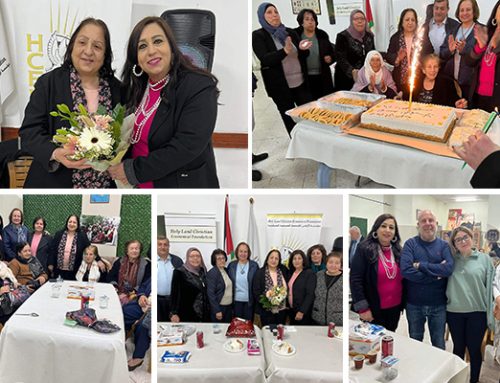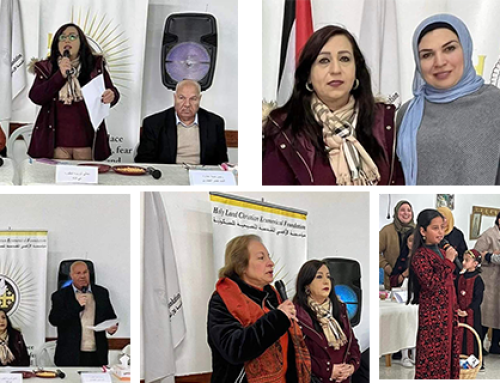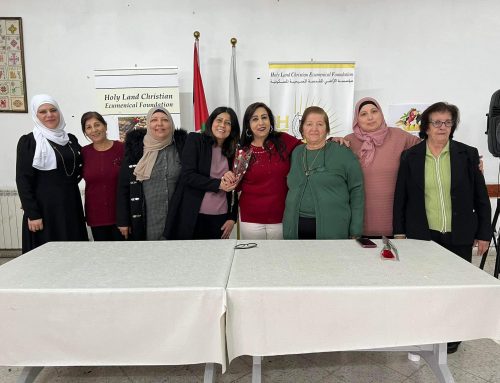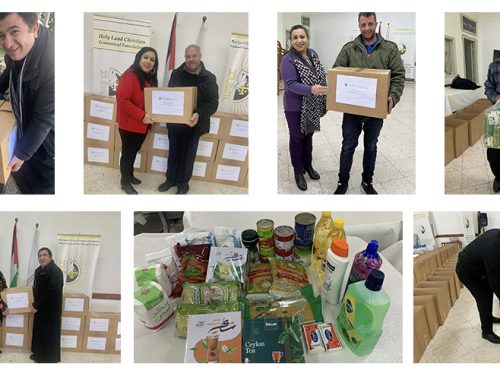Rateb Rabie, KCHS, HCEF President/CEO
Reflections on the recent J Street, AAI and HCEF conferences
On the weekend of October 23-26, 2009, a remarkable event occurred: leaders of American Jewish and American Arab organizations, as well as other interested Jewish, Christian and Muslim leaders came together. J Street, the Arab American Institute (AAI), and the Holy Land Christian Ecumenical Foundation (HCEF) held their conferences concurrently in Washington that weekend. The venues were planned months ago independently, their agendas uncoordinated. Yet during that weekend, the leadership of these organizations came together: their purpose to make clear their shared commitment to a comprehensive Middle East peace. Their traditions and starting points were different, but the vision was the same.
I was privileged to participate in these meetings. I had the profound but indescribable feeling that in some mysterious way the Spirit of the Almighty was at work, bringing us together in this noble quest!
Jeremy Ben-Ami, Founder and Executive Director of J Street, set the tone of this historic gathering by saying: “It is heart warming and hope-inspiring to look out into this room and to see tables of Jewish Americans and Arab Americans, sitting together-all of us coming together under our different umbrellas because we share a vision and a hope for the future.”
Through the years, the consensus has been voiced that the present status quo in the Israeli-Palestinian conflict does not lead to peace. As many participants noted, it is harmful to Israel itself in the long run. An unending military occupation of an indigenous population is degrading to Israel’s self-image, at variance with Judaism’s sense of justice, and corrosive to its very soul.
A new perspective was needed, the old assumptions re-examined. Can faith-based approaches provide an alternative? Can the rich religious traditions of Judaism, Christianity and Islam be a catalyst for bringing about understanding, reconciliation, and ultimately lasting peace in the land that is sacred to all?
AAI president Dr. James Zogby eloquently summarized the significance of the dialogue. Looking out at the assembled Jewish American and Arab American leaders, and special guests from the White House and Congress, he remarked, “The fact that we are doing something together should not be a big thing, is not a big thing, ought to be as normal as walking and talking and living and breathing, and it’s not. So we defy the norm, by doing the normal thing…. We are partners in this until there is a two state solution and peace in that region. We need it and everyone in the world needs it.”
During various discussions, the role of Christians in the Holy Land came up. What contribution could they make to the peace process? It was agreed that their situation was unique. — They do not have militias or a threatening military. In fact, of all the parties in the conflict region they are the most defenseless and vulnerable. They are a small minority. In a paradoxical way, it is this very weakness that could be leveraged as strength in seeking peace. They can be the indispensable bridge for reconciliation between the Jewish and Muslim communities.
In his twelve years as the Apostolic Nuncio to Israel, Archbishop Pietro Sambi is an example of what can be done. He brought together leaders of all faiths-rabbis, bishops, and imams– in the pursuit of peace, inspiring them to take chances for peace where the usual political process failed. For much too long, the peace process has been dominated by the cold calculus of secular power relationships-and it has failed dismally!
Arab Christians united with their Christian brethren in the West, particularly in America, can be powerful force for peace. The politicians in the region have mostly overlooked this potential.
In our own recently concluded HCEF conference we explored in depth: how can Christians and people of faith be catalysts for peace? Our conference theme was “Building Peace through Faith and Dialogue.” Prominent guest speakers representing the three Abrahamic traditions explored the possibilities of such an approach, shared their knowledge and wisdom. It was heartening to hear Jewish and Christian speakers trace the roots of their deepest beliefs and convictions to the timeless teachings of Abraham, the prophets and Jesus: “Blessed are the peace makers.” Likewise a Muslim imam proclaimed the universal truths of the Koran: sacredness of all human life, and God’s love of justice and mandate to love one’s neighbor.
The HCEF conference explored these timely topics on many levels. Special sessions were devoted on how religion, the media, and humanitarian outreach, particularly in the area of health services in the Holy Land, can foster the conditions for better understanding leading to peace.
In the eleven years since founding, HCEF’s principal mission has been to work in an ecumenical spirit for reconciliation and peace. In this spirit, the Foundation has reached out to all persons of good will, irrespective of their faith tradition, but motivated by the universal yearning for peace in the land that is sacred to Jews, Christians and Muslims alike.
It is this mission that continues to inspire us and countless volunteers here in the U.S. We work for the betterment in the life of those from Bethlehem to Nazareth, and in nameless hamlets and towns in between, where Jesus and the prophets once walked.
The past weekends conferences and the leadership meetings have re-energized my hopes. A new era of cooperation of Jews, Christians and Muslims for peace in the Holy Land is possible. In fact, it is ardently desired by many, as the conferences revealed.
It is my firm belief that Christian groups and churches can be the key catalyst for bridging the present Israeli-Palestinian divide and bring about peace.
In our own HCEF conference, we have re-dedicated and re-consecrated ourselves to this quest. We will not falter. We will persevere until the new dawn of peace warms the land so sacred to all of us.





